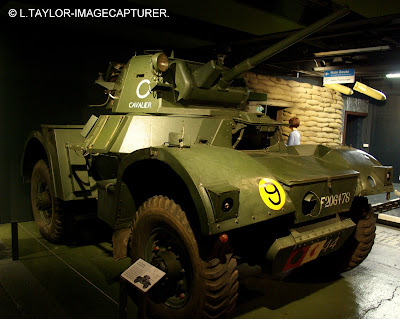HAGGLUND and SONER BV 202 OVER SNOW.
Tracked light transport.
Once the British took over its Nato role of northern flank defence of Norway it selected this fully tracked and articulated Swedish vehicle for its over snow performance. Since its introduction into British service in the late 1960`s it has become an indispensable maid-of-all work load carrier. In service- 1968. Max speed- 39 km/h. Engine- Volvo 91 bhp type B18 petrol. Width- 5 feet 9 inch. Length- 20 feet 3 inch. Armament- A 7.62mm general purpose machine gun could be fitted but was not standard.
~~~~<<<<>>>>~~~~
RESTORED WAR-TIME RAF DENTAL UNIT.
~~~~<<<<>>>>~~~~
CROSSLEY FIRE TENDER.
The tender was equipped to deal with the special hazards created by aircraft fires, water alone was useless against the primary threat of burning fuel. The fire would, therefore, be attacked with carbon dioxide gas which would clear a path through the flames, to any trapped aircrew. The tenders main pump would prepare a mixture of Saponin, water and air which when sprayed as foam, would smother the flames. The Crossley`s five man crew would remain with their vehicle, strategically parked on an airfield, whilst flying was in progress.
~~~~<<<<>>>>~~~~
DODGE WC - 62 WEAPONS CARRIER.
~~~~<<<<>>>>~~~~
DAIMLER FERRET SCOUT CAR.
First introduced in 1952 the Ferret relied on speed and agility rather than armour or armament to evade destruction. Over 4,000 were built by 1971 when production was complete. This scout car came into service with the British Army in July 1958 and was used until 1988.
~~~~<<<<>>>>~~~~
1943 DAIMLER ARMOURED CAR. MARK 1.
This vehicle is a mark 1 Daimler armoured car, it was used by the 7th armoured division of the Hussars Regiment and saw action in Northern Europe after the D - Day landings. The engine is a 4095cc straight six engine, uses a gallon of petrol every 4 miles, top speed- 41mph. The armour plating means the vehicle weighs up to 7 tons.
~~~~<<<<>>>>~~~~
RUSSIAN T 34/85 MEDIUM TANK.
Designed in 1937, the T-34 was in production by 1939 and in service in 1940 and in action against the Germans when Hitler invaded Russia in June 1941.
~~~~<<<<>>>>~~~~
QUEEN MARY TRAILER.
The lowloader Queen Mary was a semi-trailer designed to be used to transport aircraft, and also to recover crashed aircraft parts for repairs. The tractor units used to tow the trailer tended to be a 6 cylinder Perkins or Ford, Bedford tractor unit or the standard 1939-40 Prime Mover.
~~~~<<<<>>>>~~~~
MEADOWS 27.5 KVA DIESEL ENGINE DRIVEN GENERATING SET.
Engine- Meadows 4DJ 420, 4 cylinder in-line 4 stroke water cooled vertical diesel engine. Bore- 5 1/8ins. Stroke- 5 1/8ins. Compression ratio- 16.1. RPM- 1500/1800 bhp at 1500rpm. Fuel consumption- 15 pints ( 1.9 gallons ) per hour at full load. Voltage- 415/240 volts. KVA- 27.5. Power factor-0.8. Phase current- 38 amperes. Weight- 5,712lbs approx.
~~~~<<<<>>>>~~~~
RUSSIAN ML-20 152mm HOWITZER.
During the second world war, the Soviet armies used artillery on a massive scale. The ML-20 was just one of the many gun designs produced by the Russians during the war. The ML-20 was so successful it became the standard 152mm weapon with the Warsaw Pact forces after the war.
~~~~<<<<>>>>~~~~
1960`s HUMBER PIG.
The Humber Pig was used by the British Army from the 1950s until the early 1990s. It also saw service with the Royal Ulster Constabulary ( RUC ) from the late 1950s until 1970, and became well known from its presence on the streets of Northern Ireland during the worst of the troubles.
~~~~<<<<>>>>~~~~
1968 ALVIS STALWART.
The Stalwart was designed as an amphibious vehicle that could carry a five ton load over rough ground and through rivers. Top speed- on land 40 mph, in the water 5 knots.
~~~~<<<<>>>>~~~~































